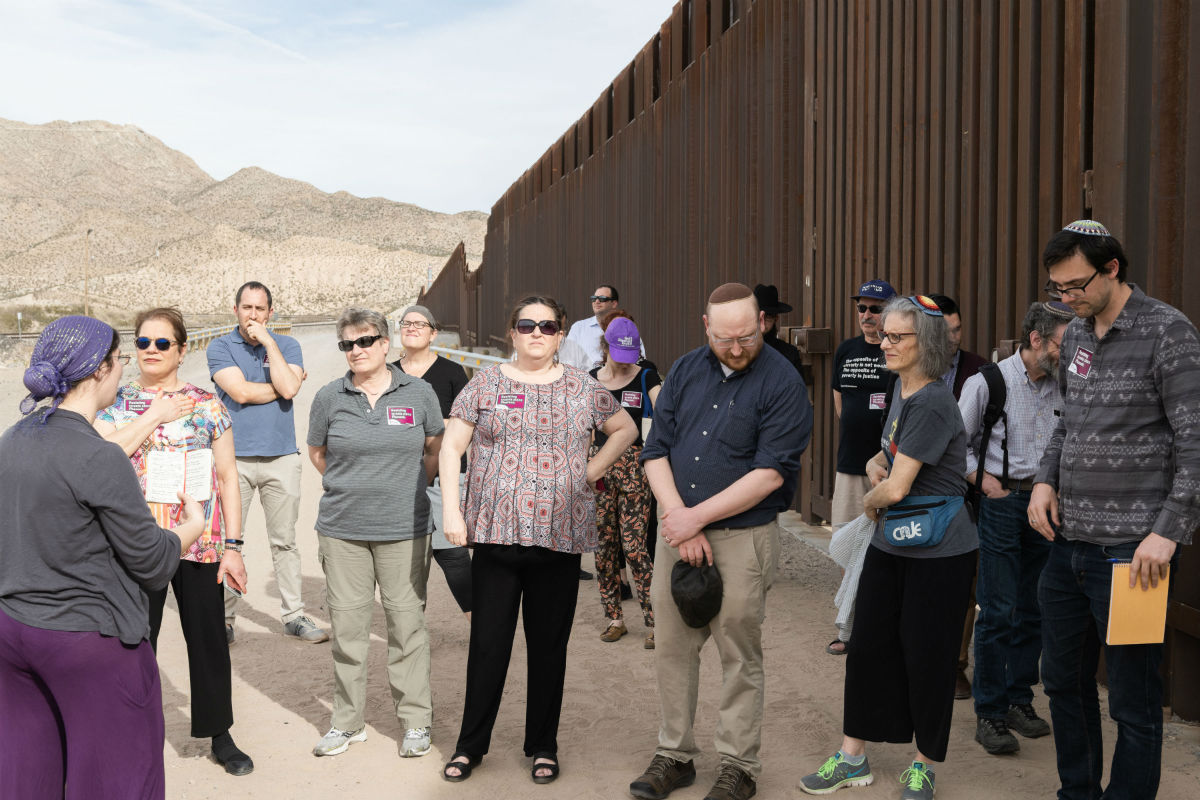T’ruah, together with our friends from HIAS, the global Jewish nonprofit that protects refugees, has brought over 100 rabbis and cantors to the United States-Mexico border to bear witness to the humanitarian crisis there.
Standing amid so much suffering and injustice was difficult, but we were heartened to meet many heroic activists working to help the thousands of immigrants and asylum seekers, whether through legal advocacy, political activism, or providing much-needed shelter and food.
Since returning home, the clergy in our delegation have shared what they saw.
Below are excerpts from pieces written by members of the delegation, with links to the full articles/blog posts. Learn more about the situation at the border and how you and your congregation can help immigrants and asylum seekers, by ordering or downloading our newly revised and expanded “Mikdash: A Jewish Guide to the New Sanctuary Movement.”
Our Religious and Moral Duty to Asylum Seekers: A Passover and Easter Reflection (New York Daily News)
Rabbi Amichai Lau-Lavie (Lab/Shul) & Rabbi Rachel Grant-Meyer (HIAS) (with Rev. Micah Bucey of Judson Memorial Church & New Sanctuary Coalition), New York City
As the Jewish community and our friends and family of all faiths gather this week, we’ll imagine ourselves as the Jews in ancient Egypt. It may be, though, that the Jewish refugee story never really ended. Instead, the role of the Jewish people in the story shifted. This is the first time in history when Jews are not predominantly refugees and are uniquely positioned to welcome and protect those in need.
Connecting the Passover Story to the Border Today (Sojourners)
Cantor Vera Broekhuysen, of Temple Emanu-El in Haverhill, Mass.
Nobody walks for six months through cartel-controlled Central American territories for fun or profit. Families are fleeing terror and persecution. As McAleenan spoke to the cameras, not the humans yards away, I locked eyes in Ciudad Juarez’s migrant shelter Casa del Migrante with Sofia, a Jewish Honduran nurse who’d come to the border with her 13-year-old son. She asked who we were, and in my passable Spanish I explained. “Shalom!” she smiled. Expensive medical equipment had been stolen from the government hospital where she worked; she’d reported it, and the Honduran government had persecuted her. She’d taken her boy and ran. “He’ll miss his bar mitzvah,” she said ruefully. Two older sons remained behind. I asked her if she’d crossed the border yet. No, she said. She had a number. She was waiting.
The Passover Story Revisited from the Lens of the U.S. Border (The Olympian)
Rabbi Seth Goldstein, of Temple Beth Hatfiloh in Olympia, Wash.
Passover is a story of the reality, necessity, and challenge of migration, and it is why these contemporary issues of immigration resonate with us as Jews. It is a reminder that the act of migration is a just act, one that must be met with compassion. It also teaches us that just because something is now or has been, it doesn’t mean it has to be.
At the Southern Border, a Laboratory of Injustice, a Landscape of Hope (Tikkun Magazine)
Rabbi Victor Reinstein, Nehar Shalom Community Synagogue in Jamaica Plain, Mass.
I thought often of the challenge set forth by Rabbi Samson Raphael Hirsch (19th century Germany) in his Torah commentary to Exodus chapter 23, verse 9 on the Torah’s oft repeated exhortation not to mistreat or oppress the stranger: “The treatment accorded by a state to the aliens living within its jurisdiction is the most accurate indication of the extent to which justice and humanity prevail in that state.”
We Owe Refugees Compassion (VT Digger)
Rabbi Amy Small, Ohavi Zedek Synagogue in Burlington, Vt.
It is time for our government to address the core issues that have created the desperation that drives thousands to flee on treacherous journeys north. Border control can’t solve this problem; only systemic change will work. We need the wisdom and courage to address this change.
The faces of the children, teens and families will haunt me forever, but particularly this Passover, as we tell the story of our own people’s liberation. We owe these asylum seekers the same liberation. We owe them this as fellow human beings. We owe them this as people of faith. We owe them this as Americans.
The Politics of a Hug (New York Jewish Week)
Rabbi Susan Falk (Brooklyn, N.Y.)
Our administration’s policies are not just inhumane. They are in conflict with our most basic Jewish values. During this time in the Jewish calendar, we have been counting the Omer, the days between our freedom from slavery and our receiving the Torah — which opens by stating the inherent equality of all people, that we are all created b’tzelem Elohim, in the image of God.
The Exodus Along the U.S. Southern Border (New Jersey Jewish News)
Rabbi Ethan Prosnit, Temple Emanu-El of Westfield (Westfield, N.J.)
At the southern border our Exodus story is unfolding — one for which we can help write the ending. There is a humanitarian crisis as thousands come across the border daily with limited access to lawyers and due process. My trip with T’ruah and HIAS opened my eyes and heart to this emergency and the need to exercise compassion as part of our country’s immigration policies.
America, The Sea of Reeds (The Jewish News of Greater Phoenix and Northern Arizona)
Rabbi Elyse Wechterman, Reconstructionist Rabbinical Association (Wyncote, Pa.)
When did America become the Reed Sea, an overwhelming force holding back progress toward freedom and liberation for our fellow humans? With the exception of our Native American neighbors, we are a nation of people from somewhere else. We Jews especially resonate with this story. Not only do we remember walking out of Egypt and across the sea, but we also remember all the other journeys in our people’s history: out of Eretz Yisrael to Babylon, out of Spain toward Africa and the New World, out of Eastern Europe to the Goldene Medina of the United States.
Ridgefield Rabbi Encounters Barbed Wire, Asylum Seekers (Danbury News Times)
Rabbi David Reiner, of Congregation Shir Shalom in Ridgefield, Conn.
As he walked across the bridge, Reiner said he was reminded of his great-grandparents, themselves refugees from Eastern Europe, who came to America by ship. “I am not sure how the people we saw in detention/processing are significantly different,” he said.
A Passover Message from the Southern Border (Gay City News)
Rabbi Yael Rapport & Rabbi Michael Moskowitz, of Congregation Beth Simchat Torah (CBST), New York City
We understand as Jews and human beings that we as individuals are not exempt from owning the darkest sins of our community. Whether we participate, whether we are passive, or whether we protest — while we remain accountable, we have the power to determine our response.
Healing from the Affliction of Separation (Bayit Builders Blog)
Rabbi Michael Moskowitz, of CBST
Let My People Go (Rav Blog)
Rabbi Suzanne Singer, of Temple Beth El in Riverside, Calif.
Under international and federal law, people have the right to request asylum. Asylum seekers are not criminals; many are people with legitimate fears of being killed in their countries of origin. Why are we treating them like this? Judaism certainly insists that we are all made b’tzelem Elohim, in God’s image. How do we as a country justify making a profit off those seeking safety by locking them up in private prisons?


